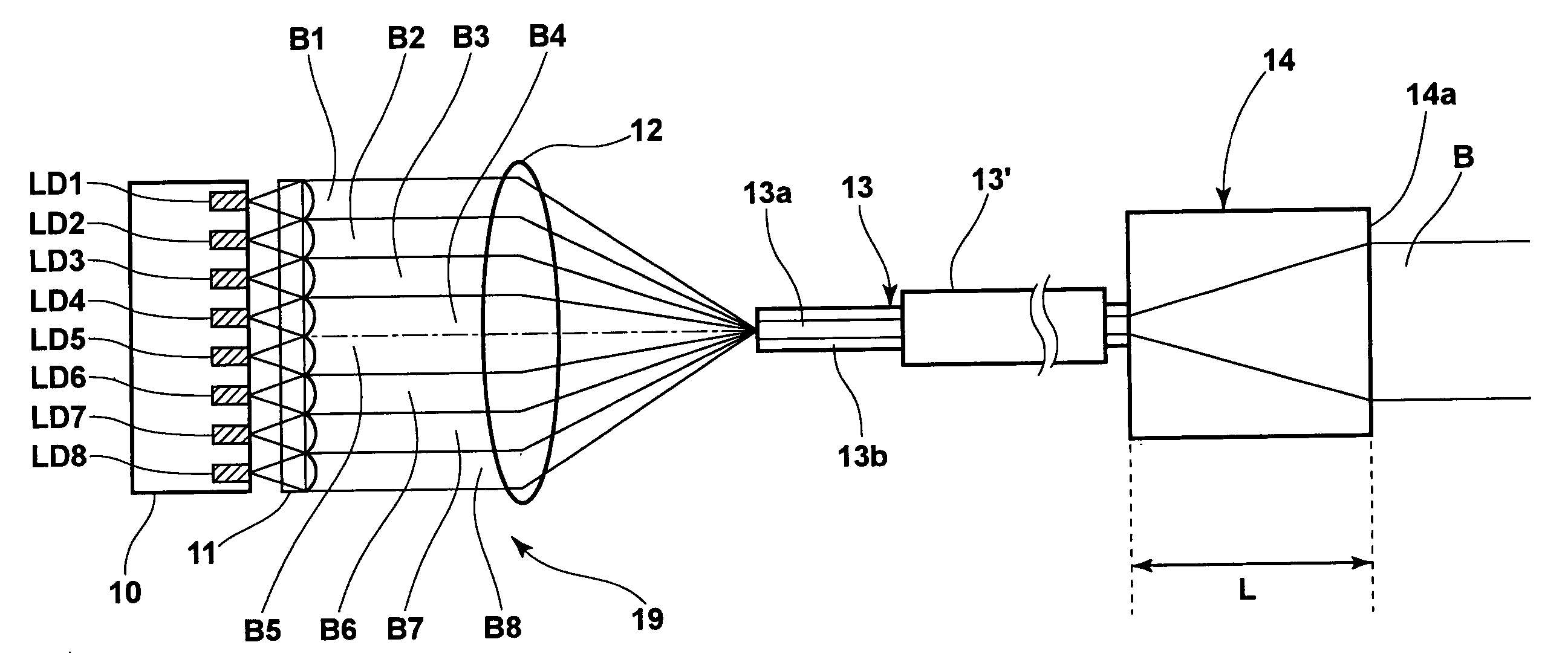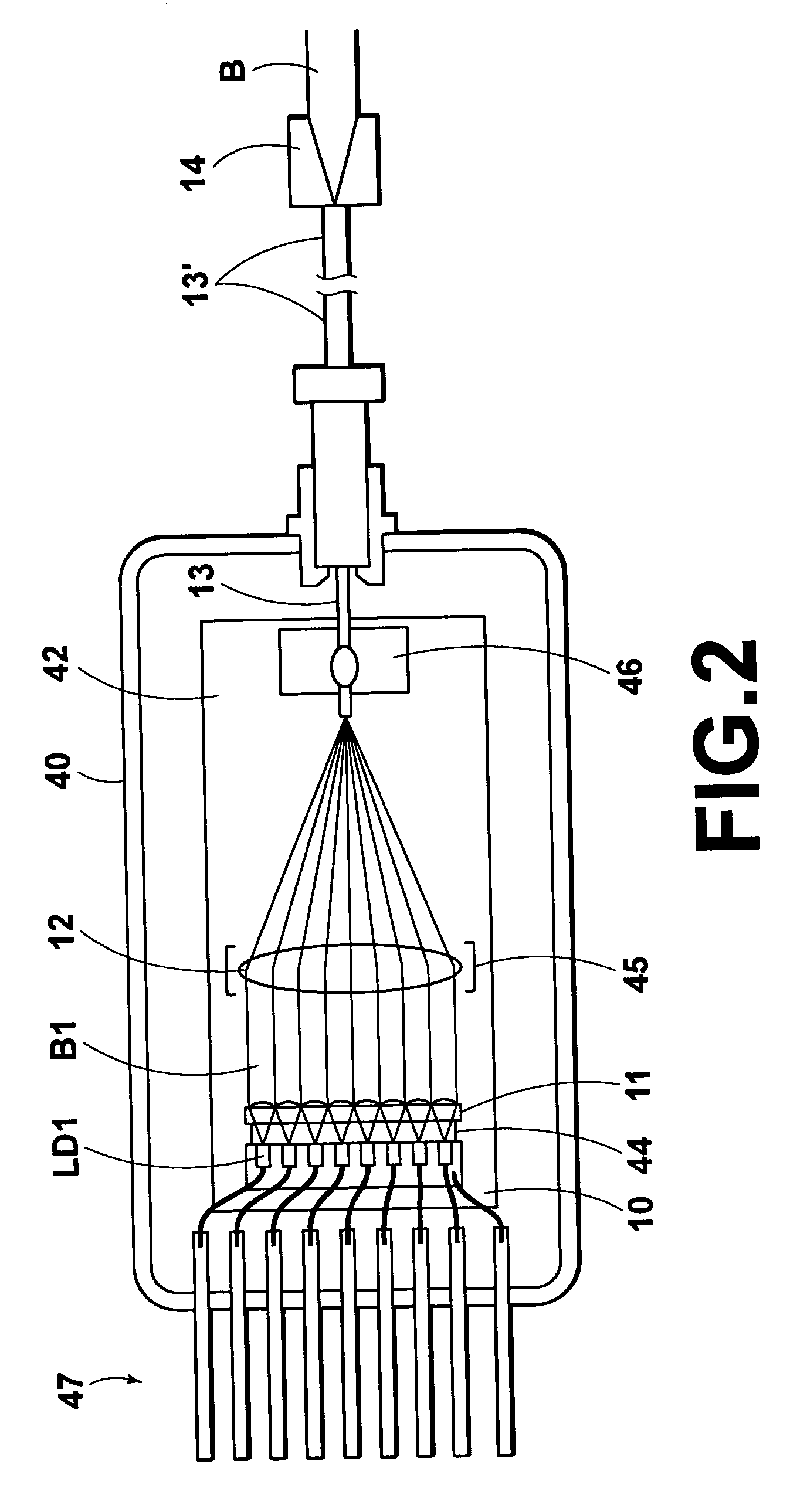Laser apparatus having protection member at light-emission end of multimode optical fiber
- Summary
- Abstract
- Description
- Claims
- Application Information
AI Technical Summary
Benefits of technology
Problems solved by technology
Method used
Image
Examples
first embodiment
[0058] FIG. 1 is a diagram illustrating an outline of a laser apparatus according to the first embodiment of the present invention, and FIGS. 2 and 3 are schematic plan and side views of a module containing the laser apparatus of FIG. 1.
[0059] The laser apparatus of FIG. 1 is constituted by a heat block (heat-dissipation block) 10, GaN-based semiconductor laser chips LD1 through LD8, a collimator-lens array (microlens array) 11, a condensing lens 12, a multimode optical fiber 13, and a glass element 14.
[0060] The heat block 10 is made of copper or a copper alloy. The GaN-based semiconductor laser chips LD1 through LD8 are fixed on the heat block 10, and each of the GaN-based semiconductor laser chips LD1 through LD8 has a single cavity, and operates in a single transverse mode. The glass element 14 has a shape of a rectangular parallelopiped with a thickness L of about 2 mm, and is fixed to a light-emission end of the multimode optical fiber 13 by fusion.
[0061] Note that FIG. 1 show...
second embodiment
[0073] Next, the laser apparatus according to the second embodiment of the present invention will be explained below. The laser apparatus according to the second embodiment is different from the first embodiment in only the protection member which is arranged in a vicinity of a light-emission end face of a multimode optical fiber. Therefore, the explanations on the semiconductor laser elements, the optical condensing system, and the optical multiplex system are not repeated here unless necessary. FIG. 5 is a side view of the protection member in the laser apparatus according to the second embodiment.
[0074] As in the first embodiment, the multimode optical fiber is constituted by a core and a cladding surrounding the core, and the multimode optical fiber is covered with resin. In FIG. 5, the resin-covered multimode optical fiber is indicated by reference numeral 13'. In addition, as in the alternative construction of the first embodiment, the circumference of a portion 23 of the mult...
third embodiment
[0083] Next, the laser apparatus according to the third embodiment of the present invention will be explained below. The laser apparatus according to the third embodiment is different from the first embodiment in only the protection member which is arranged in a vicinity of a light-emission end of a multimode optical fiber. Therefore, the explanations on the semiconductor laser elements, the optical condensing system, and the optical multiplex system are not repeated here unless necessary. FIG. 6 is a plan view of the protection member in the laser apparatus according to the third embodiment of the present invention.
[0084] As illustrated in FIG. 6, a metalized portion 23 of the multimode optical fiber is fixed on a holder 34 in a package 30, which has a glass window 31 as a light-emission window. The package 30 has a gas inlet 32a and a gas outlet 32b. In addition, a gas circulation system comprising a filter 35, a pump 36, a valve 37, and a gas cylinder 38 is provided. The filter 3...
PUM
 Login to View More
Login to View More Abstract
Description
Claims
Application Information
 Login to View More
Login to View More - R&D
- Intellectual Property
- Life Sciences
- Materials
- Tech Scout
- Unparalleled Data Quality
- Higher Quality Content
- 60% Fewer Hallucinations
Browse by: Latest US Patents, China's latest patents, Technical Efficacy Thesaurus, Application Domain, Technology Topic, Popular Technical Reports.
© 2025 PatSnap. All rights reserved.Legal|Privacy policy|Modern Slavery Act Transparency Statement|Sitemap|About US| Contact US: help@patsnap.com



